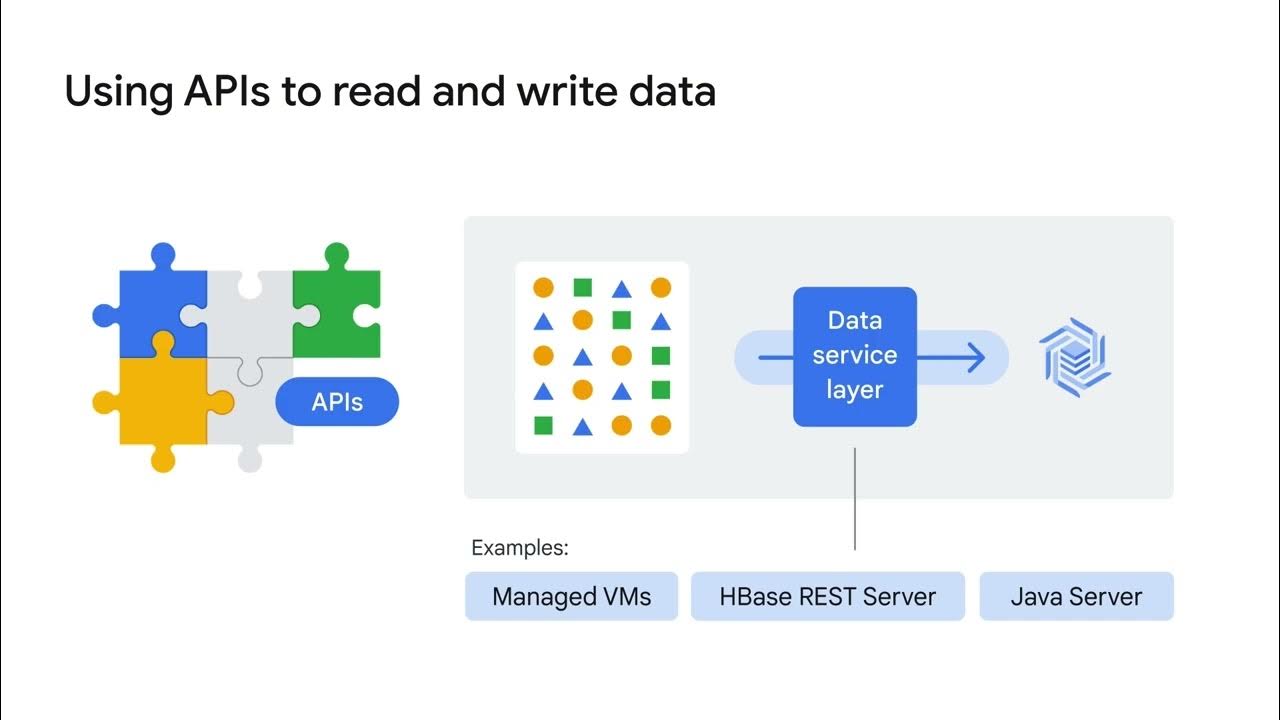Cloud Bigtable
Summary
TLDRCloud Bigtable is a fully managed NoSQL database designed for massive scalability, low-latency access, and high throughput. It powers key Google services like Search, Maps, and Gmail, and is ideal for both operational and analytical tasks such as IoT, user analytics, and machine learning. Cloud Bigtable integrates with big data tools like Hadoop and supports the open-source HBase API for easy adoption. Its architecture allows seamless scaling, distributing workloads evenly across nodes. For high-volume, low-latency needs, Cloud Bigtable is an excellent option, while Firestore is better for smaller scale requirements.
Takeaways
- 🚀 Cloud Bigtable is a fully managed NoSQL database with petabyte-scale and very low latency.
- ⚡ It seamlessly scales for throughput and adjusts to specific access patterns automatically.
- 🌍 Cloud Bigtable powers many of Google’s core services, including Search, Maps, and Gmail.
- 📊 It’s a great option for both operational and analytical applications like IoT, user analytics, and financial data analysis.
- 🧠 Cloud Bigtable is an ideal storage engine for machine learning applications due to its high throughput and low latency.
- 🔗 It integrates easily with popular big data tools such as Hadoop, Cloud Dataflow, and Cloud Dataproc.
- 🔑 Data in Cloud Bigtable is stored in scalable tables consisting of rows and columns, with each row indexed by a single row key.
- 🏷️ Each row/column intersection can contain multiple versions of data, allowing a historical record of changes over time.
- 📈 Cloud Bigtable's architecture includes front-end servers and nodes handling processing, with data stored in Google's Colossus file system in SSTable format.
- 💡 If you need more than 1 TB of structured data storage, low latency, high write volumes, or HBase API compatibility, Cloud Bigtable is an excellent choice.
Q & A
What is Cloud Bigtable?
-Cloud Bigtable is a fully managed NoSQL database designed for petabyte-scale data storage and low-latency operations. It seamlessly scales for high throughput and adjusts to access patterns.
What kind of applications is Cloud Bigtable suitable for?
-Cloud Bigtable is ideal for both operational and analytical applications, including IoT, user analytics, financial data analysis, and machine learning, thanks to its high read/write throughput and low latency.
How does Cloud Bigtable scale its performance?
-Cloud Bigtable scales linearly in terms of throughput. For each additional node you add to the cluster, you'll see a corresponding increase in performance, up to hundreds of nodes.
What is the role of column families in Cloud Bigtable?
-In Cloud Bigtable, columns related to one another are grouped into a column family. Each cell is identified by the combination of a column family and a column qualifier, allowing flexible and sparse data storage.
What is a tablet in Cloud Bigtable, and why is it important?
-A tablet is a block of contiguous rows that helps distribute the workload for queries. It’s similar to HBase regions and plays a key role in balancing the workload across nodes.
What are some of the core Google services powered by Cloud Bigtable?
-Cloud Bigtable powers many of Google's core services, including Search, Analytics, Maps, and Gmail, showing its capability to handle massive data loads with high performance.
How does Cloud Bigtable handle data sparseness?
-Cloud Bigtable tables are sparse, meaning if a cell doesn't contain data, it doesn't take up space. This feature allows for efficient storage and flexibility in adding new columns as data evolves.
What is the HBase API, and how does Cloud Bigtable support it?
-Cloud Bigtable supports the open-source HBase API, which makes it easy for development teams already familiar with HBase to start using Cloud Bigtable without significant changes.
What is the smallest Cloud Bigtable cluster you can create, and what is its capacity?
-The smallest Cloud Bigtable cluster you can create has three nodes and can handle 30,000 operations per second. However, you will be charged for those nodes whether they’re in use or not.
What storage format does Cloud Bigtable use for its data?
-Cloud Bigtable stores its data in Google's Colossus file system using the SSTable format, which is an immutable, ordered map of keys to values. Both the keys and values are arbitrary byte strings.
Outlines

This section is available to paid users only. Please upgrade to access this part.
Upgrade NowMindmap

This section is available to paid users only. Please upgrade to access this part.
Upgrade NowKeywords

This section is available to paid users only. Please upgrade to access this part.
Upgrade NowHighlights

This section is available to paid users only. Please upgrade to access this part.
Upgrade NowTranscripts

This section is available to paid users only. Please upgrade to access this part.
Upgrade Now5.0 / 5 (0 votes)





